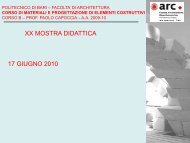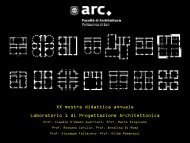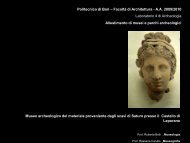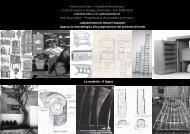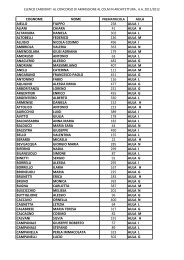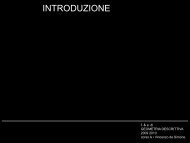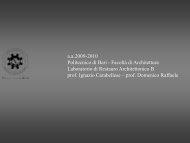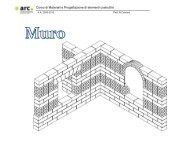44. I regolamenti <strong>di</strong>dattici148Aims and contentsThe target of the course is to extend thedesign competences acquired during theprevious Interior design stu<strong>di</strong>os, and toexplore the techniques of woodworkmanship and its expressivepotentialities.At this end the student w<strong>il</strong>l learn the three<strong>di</strong>mensionalcomputer modellingtechniques.The design problem is the study of a“wooden wall” situated in a room.The project makes reference to:• plane walls with simple joint connectionsor simple ben<strong>di</strong>ng conformation;• walls with spatial joint connections andthree-<strong>di</strong>mensional or double ben<strong>di</strong>ngconformation.Articolazione delle attività <strong>di</strong>datticheL’attività del corso è articolata in tre fasi,ciascuna delle quali prevede lezioni edesercitazioni.Articulation of the educational activitiesThere are three phases, each characterizedby lessons and applications.Iscrizione al corsoLe iscrizioni avvengono obbligatoriamentesulla piattaforma e-learning entro i primi<strong>di</strong>eci giorni dall’inizio dei corsi. Periscriversi lo studente deve avere sostenutotutte le propedeuticità previste:Laboratorio <strong>di</strong> Arredamento 1/I eLaboratorio <strong>di</strong> Arredamento 2/I.Modalità d’esameL’esame consisterà nella <strong>di</strong>scussione criticasui temi esposti durante le lezioni teoricocritichee sul tema d’anno progettualesvolto durante <strong>il</strong> semestre, tale da<strong>di</strong>mostrare una piena comprensione delleproprie scelte critiche e progettuali.Laboratorio <strong>di</strong> Progettazione grafica 2/IIGraphic Design Stu<strong>di</strong>o 2/IILPG 2/II-7,5 cfu2° anno / corso semestrale (II semestre)Area <strong>di</strong>dattica I:Progetto del prodotto industriale:• Icar 13, Disegno industriale• Icar 16, Architettura degli interniLeonardo DirenzoProgettazione grafica 2/II (Icar 13-5 cfu)Daniela TurchiCultura tecnologica della progettazionegrafica 2/II (Icar 12-2,5 cfu)Finalità e contenuti <strong>di</strong>sciplinariTema del laboratorio sarà la progettazione<strong>di</strong> un carattere tipografico.Gli studenti realizzeranno una fontfunzionante, installab<strong>il</strong>e su computer,completa del set alfanumerico e <strong>di</strong> unaserie <strong>di</strong> simboli integrati.Si tratterà <strong>di</strong> un carattere per testi:questo, a <strong>di</strong>fferenza <strong>di</strong> un genericocarattere per titolazione, dovrà prevedereuna cura particolare agli aspetti percettivi,<strong>di</strong> visib<strong>il</strong>ità e <strong>di</strong> leggib<strong>il</strong>ità, in grado <strong>di</strong>assicurarne la fruizione.Gli aspetti <strong>di</strong> progettazione sistemicasaranno altrettanto importanti, perché <strong>il</strong>sistema <strong>di</strong> segni costituito dal caratterepossa avere le appropriate qualità <strong>di</strong>coerenza formale funzionali allaleggib<strong>il</strong>ità.Aims and contentsThe design problem is of a typographicalcharacter.The students w<strong>il</strong>l realize a real font, to beinstalled on a computer, complete with analphanumeric set and of a series ofintegrated symbols.It w<strong>il</strong>l deal with a character for textswhich,unlike a generic character for titles, payingparticular attention to the perceptive,visib<strong>il</strong>ity and legib<strong>il</strong>ity aspects to assure itsfruition.The aspects of systemic planning w<strong>il</strong>l be asimportant, because the system of signsconstituted by the character could have aappropriate formal coherence qualityfunctional to its legib<strong>il</strong>ity.Articolazione delle attività <strong>di</strong>datticheIl lavoro <strong>di</strong> laboratorio sarà integrato dauna serie <strong>di</strong> lezioni teoriche relative a<strong>di</strong>versi aspetti della progettazionetipografica, della sua storia e delle sueapplicazioni nella comunicazione:• la tipografia a base calligrafica, inparticolare quella quattro-cinquecentesca;• l’emancipazione dalla calligrafia e lascientifizzazione della tipografia, inparticolare <strong>il</strong> caso del Romain du Roi;• l’evoluzione dall’incisione manuale deipunzoni a quella realizzata con <strong>il</strong> pantografo;• usi e<strong>di</strong>toriali della tipografia a piombo;• i limiti della tipografia razionalista;• la progettazione al computer;• l’integrazione del carattere tipograficonella grafica contemporanea;• prospettive <strong>di</strong> scrittura non tipografica alcomputer.Articulation of the educational activitiesTheoretical lessons w<strong>il</strong>l be related to<strong>di</strong>fferent aspects of the typographic design,its history and its applications in
communication, as follows:• typography with a handwriting base,particularly that of the fifth to sixteenthcentury;• the emancipation from calligraphy andthe science of typography, particularly thecase of the Romain du Roi;• the evolution from manual incision withpunches to incision realized with thepantograph;• e<strong>di</strong>ting with lead typography;• the limits of rationalist typography;• computer graphic design;• the integration of the typographicalcharacter in contemporary graphics;• perspectives of non typographical writingfor the computer.Iscrizione al corsoLe iscrizioni avvengono obbligatoriamentesulla piattaforma e-learning entro i primi<strong>di</strong>eci giorni dall’inizio dei corsi.Modalità d’esameL’esame finale consisterà nellapresentazione <strong>di</strong> testi composti nelcarattere progettato, e nella loro<strong>di</strong>scussione e valutazione.Storia delle arti decorative eindustriali 2/IIHistory of Decorative andIndustrial Arts 2/IIIcar 18-5 cfu2° anno / corso semestrale (II semestre)Area <strong>di</strong>dattica II:Storia delle forme del prodotto industriale:• Icar 18, Storia dell’architettura• L-Art 02, Storia dell’arte moderna• L-Art 03, Storia dell’arte contemporaneaAnnalinda NegliaFinalità e contenuti <strong>di</strong>sciplinariIl corso ha l’obiettivo <strong>di</strong> fornire gli elementiconoscitivi e gli strumenti critici per lacomprensione della storia dei processiartistici e industriali in Italia nel XX secolo.Il processo <strong>di</strong> trasformazione delle tecnicheindustriali, del gusto e delle teorieprogettuali in Italia nel Novecento verràanalizzato ut<strong>il</strong>izzando come strumento d<strong>il</strong>avoro le riviste <strong>di</strong> settore quali Architetturae Arti Decorative, La Casa Bella, Domus,Emporium e a partire dalle esposizioni <strong>di</strong>arti decorative e design quali la Biennale <strong>di</strong>Monza e la Triennale <strong>di</strong> M<strong>il</strong>ano.Aims and contentsThe aim of the course is to providestudents cognitive elements and criticaltools for the comprehension of the historyof artistic and industrial processes in Italy,during the XX century.The process of transformation of theindustrial techniques, of the taste and ofdesign theories in Italy during the XXcentury w<strong>il</strong>l be analyzed using as a workingtool reviews such as Architettura e ArtiDecorative, La Casa Bella, Domus,Emporium plus exhibitions of decorativearts and design such as the Biennale <strong>di</strong>Monza and the Triennale <strong>di</strong> M<strong>il</strong>ano.Articolazione delle attività <strong>di</strong>datticheL’attività del corso è articolata in treperio<strong>di</strong>, ognuno dei quali fondato su <strong>di</strong> unciclo omogeneo <strong>di</strong> lezioni e seminari:1. Il novecento e l’industria delle artidecorative-Le arti decorative al tempodell’Esposizione <strong>di</strong> Parigi del 1925-Il Novecento: design e arti decorative inItalia-Grafica e comunicazione visiva nel XXsecolo2. Il razionalismo e la pretesa <strong>di</strong>industrializzazione-L’influenza delle teorie artistiche earchitettoniche internazionali sul panoramaitaliano-Le triennali <strong>di</strong> Monza e <strong>di</strong> M<strong>il</strong>ano e <strong>il</strong>design in Italia negli anni ‘40-L’industrializzazione in Italia e lo sv<strong>il</strong>uppodel design nel periodo razionalista3. Il dopoguerra e lo sv<strong>il</strong>uppo industriale-Il dopoguerra-Gli anni ’60 e <strong>il</strong> nuovo design italiano-Il design italiano negli anni ’80 e ‘90Alla fine <strong>di</strong> ciascun ciclo è previsto un extempore <strong>di</strong> sintesi critica dei temi trattaticonsistente nella redazione <strong>di</strong> una schedacritica relativa a un prodotto industriale, <strong>di</strong>arredo o <strong>di</strong> grafica, <strong>di</strong> cui saranno messi inevidenza i caratteri morfologici e linguisticiin relazione al contesto storico in cui èstato progettato.Articulation of the educational activitiesThe educational activity is articulated intothree main periods, each one characterizedby a group of homogeneous lectures andseminars:1. The Italian Novecento and the industry ofdecorative arts-Decorative Arts at the time of the Expositionof Paris in 1925-Novecento: design and decorative arts inItaly-Graphic and visual communication duringthe XX century2. The Italian Rationalism and the pretensionof industrialization-The influence of the international artistic andarchitectural theories on the Italian scene-The Triennale <strong>di</strong> Monza and the Triennale <strong>di</strong>M<strong>il</strong>ano: design in Italy in the ‘40s-Industrialization in Italy and thedevelopment of design during theRationalism3. The post-war period and theindustrialization-The post-war period-’60 and the new Italian design-Italian design during the ’80s and ‘90sAt the end of each period an ex tempore ofcritical synthesis of the main arguments isexpected, consisting in a critical record on aproduct of industrial, graphic or interiordesign. These records w<strong>il</strong>l point outmorphological and linguistic characters ofproducts related to the historical context inwhich these were designed.Iscrizione al corsoLe iscrizioni avvengono obbligatoriamentesulla piattaforma e-learning entro i primi44.3.21 Progetti <strong>di</strong>dattici 2° anno149
- Page 1:
0607Politecnico di BariFacoltà di
- Page 4 and 5:
Politecnico di Bari, Facoltà di Ar
- Page 6 and 7:
4. Regolamenti didattici4.1. Il Reg
- Page 8 and 9:
PresentazionePresentazioneLa Facolt
- Page 11 and 12:
Le strutture didattiche e di suppor
- Page 13 and 14:
giorno e dando, quindi, esecutivit
- Page 15 and 16:
• esprimere pareri sui compiti di
- Page 17 and 18:
1.3. La Biblioteca di FacoltàIl pa
- Page 19 and 20:
2. Strutture di ricerca e di suppor
- Page 21 and 22:
BIO 07, Ecologia43 Mariavaleria Min
- Page 23 and 24:
le richieste e le iniziative ad ess
- Page 25:
2.3 Le biblioteche d’area2.3.1 Le
- Page 28 and 29:
33. La didattica e gli studenti263.
- Page 31 and 32:
4. I Regolamenti didattici4.1. Rego
- Page 33 and 34:
presente regolamento;• le propede
- Page 35 and 36:
discussi ed i voti finali.Per ciasc
- Page 37 and 38:
4.2.4 Definizione delle aree discip
- Page 39 and 40:
laurea da attivare in base al numer
- Page 41 and 42:
non venga superato l’iscrizione a
- Page 43 and 44:
Manifesto del CdLs in Architettura
- Page 45 and 46:
Manifesto del CdLm in Architettura
- Page 47 and 48:
ciclo provenendo da altri Atenei.È
- Page 49 and 50:
Manifesto del CdLs in Architettura
- Page 51 and 52:
Manifesto del CdLm in Architettura
- Page 53 and 54:
Insegnamenti ssd Crediti Laboratori
- Page 55 and 56:
Insegnamenti ssd Crediti Laboratori
- Page 57 and 58:
Insegnamenti attivati e docenti per
- Page 59 and 60:
Insegnamenti attivati e docenti per
- Page 61 and 62:
Finalità e contenuti disciplinariN
- Page 63 and 64:
Lezioni- L’architettura etrusca e
- Page 65 and 66:
ibliografiche, volte ad acquisire g
- Page 67 and 68:
Discipline tecnologiche per l’Arc
- Page 69 and 70:
Istituzioni di geometria I + Istitu
- Page 71 and 72:
architettonicoTopicsLife drawing, u
- Page 73 and 74:
• Representation of the shadows
- Page 75 and 76:
frequenza del corso che consentel
- Page 77 and 78:
capacità di valutazione storico-cr
- Page 79 and 80:
scale edilizie e tra diversi tipi;
- Page 81 and 82:
planning of Roman suburban andcount
- Page 83 and 84:
mutation through the works of the p
- Page 85 and 86:
-Equazioni indefinite di equilibrio
- Page 87 and 88:
coerenza tra qualità funzionale, c
- Page 89 and 90:
transformations (psychrometry).In t
- Page 91 and 92:
madrepatria.4. La colonizzazione e
- Page 93 and 94:
EtruscologiaEtruscologyL-ANT/07 - 4
- Page 95 and 96:
Archeologia e Storia dell’Arte Ro
- Page 97 and 98:
The student will develope the archi
- Page 99 and 100: tanto il rapporto tra elementi, str
- Page 101 and 102: sociale dell’abitare (Loos, Tesse
- Page 103 and 104: experimental research into the beha
- Page 105 and 106: Articolazione dell’attività dida
- Page 107 and 108: Aims and contentsThe Urban Sociolog
- Page 109 and 110: nell’ambito dell’annuale “mos
- Page 111 and 112: di laurea. Sarà quindi necessario
- Page 113 and 114: - Ancient modern Rome: the continui
- Page 115 and 116: During the lessons, theoretical and
- Page 117 and 118: Le esercitazioni costituiscono lo s
- Page 119 and 120: typological and technical innovatio
- Page 121 and 122: • la fenomeni di propagazione del
- Page 123 and 124: Aims and contentsThe urban economy,
- Page 125 and 126: value of a civil apartment with the
- Page 127 and 128: l’elaborazione della tesi di rice
- Page 129 and 130: 4.3.8 Esame di laureaPer essere amm
- Page 131 and 132: semestrale• Laboratori di sintesi
- Page 133 and 134: 4.3.14 Manifesto del CdL in Disegno
- Page 135 and 136: 4.3.16 Organizzazione delle attivit
- Page 137 and 138: 4.3.17 Insegnamenti e docenti per a
- Page 139 and 140: Laboratorio di Disegno industriale
- Page 141 and 142: • metodo dell’assonometria;•
- Page 143 and 144: fine dell’Ottocento; le avanguard
- Page 145 and 146: Iscrizione al corsoLe iscrizioni av
- Page 147 and 148: Laboratorio di Arredamento 2/IInter
- Page 149: Disegno 2/IIDrawing 2/IIIcar 17-5 c
- Page 153 and 154: 4.3.22 Progetti didattici3° anno
- Page 155 and 156: sintetiche, segnaletica interna ed
- Page 157: esercitazioni pratiche, attività d
- Page 160 and 161: 55. Relazioni internazionali1585.1
- Page 163 and 164: 6. Post Lauream6.1. Dottorato di Ri
- Page 165 and 166: Attività di ricercaLo svolgimento
- Page 167 and 168: particolari e specifiche competenze
- Page 169 and 170: iscrizione all’esame di ammission
- Page 171 and 172: scientifico-disciplinare in cui è
- Page 173: • alla sicurezza statica (corrett
- Page 176 and 177: a.1 Planimetria del campus epiante
- Page 178 and 179: Status accademico dei docentiDocent
- Page 180 and 181: aAppendici178A.3 Indice dei nomiAAc
- Page 182 and 183: aAppendicia.5 Calendario annuale de




